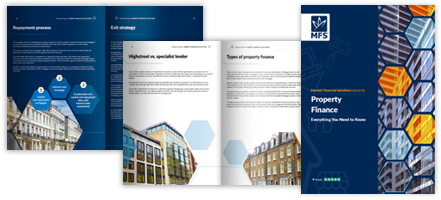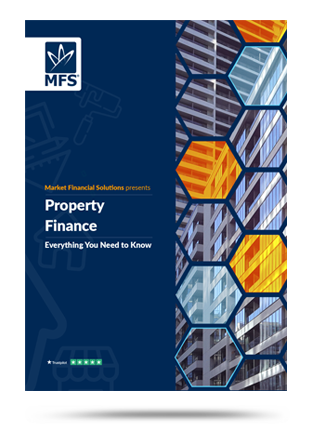Disclaimer
Market Financial Solutions are a bridging loan and buy-to-let mortgage provider, not financial advisors. Therefore, Investors are encouraged to seek professional advice. The information in this content is correct at time of writing.

Swap rates play a crucial role in the property and lending markets. But what exactly are they, and how are swap rates determined?
Concerning the broader financial industry, Investopedia[1] explains it as such: “The swap rate is a fixed interest rate that is used to calculate the fixed payments in a derivative instrument called an interest rate swap. An interest rate swap is a financial contract between two parties who agree to exchange interest rate cash flows based on a notional amount.
For an interest rate swap, two types of interest rates are required: a fixed interest rate and a floating interest rate. The fixed rate is the predetermined rate that one party agrees to pay, while the floating rate is based on a reference rate such as a government bond yield.
The swap rate is the fixed rate that is agreed upon in the swap contract. It is the interest rate at which one party will make fixed payments to the other party over the life of a swap. The swap rate remains constant for the duration of the swap agreement.”
In layman’s terms[2], swap rates are what lenders pay to financial institutions and corporations in order to acquire fixed funding for a certain period of time. This could be for two, three, five, or ten years etc.
Banks, building societies, and other lenders will use swaps to manage interest rates exposure, optimise pricing strategy, and be able to offer fixed pricing to their customers. Swap rates, essentially, indicate where the market(s) think interest rates will be in the future – if they’ll go up or down[3]. Typically, if swap rates go down, mortgage rates also drop. If swap rates rise, so too do mortgage rates.
Swap rates allow lenders to assess how much risk they may be exposing themselves to. Where swap rates get a bit too chaotic, lenders may be forced to take dramatic actions to protect themselves and their customers. For instance, if swap rates rise too quickly, lenders may pause their lending or withdraw products until prices stabilise.

Factors That Influence Swap Rates – How are Swap Rates Determined?
Swap rates can change on a daily basis, meaning it can be tricky to get a snapshot of where we stand. Having said that, Mortgage Finance Brokers[4] track swap rate movements on their site. In late September 2024, the UK swap rates were:
- 1 year – 4.22%
- 2 year – 3.81%
- 3 year – 3.66%
- 5 year – 3.54%
- 7 year – 3.50%
- 10 year – 3.54%
Given that they move, the question remains, how are swap rates determined? What influences their movements?
Broadly, swap rates are influenced by variety of factors, which includes domestic and international macroeconomic indicators like GDP, inflation expectations, supply and demand for fixed payments, bond yields, general market expectations of how the interest rates will move in the future, and central bank’s monetary policy. On the latter, the Bank of England has started the process of lowering the base rate from 16-year highs.
As such, swap rates have fallen recently, with markets expecting the BoE’s current rate cutting cycle to complete within two years or so[5]. High street lenders have caught onto this, with some of our biggest names cutting their rates in recent weeks.
The tenor(s) involved may also impact how swap rates are determined. A swap tenor refers to the length of time over which a swap remains in effect. It’s calculated from the initiation date to the maturity date, and the tenor can vary depending on the needs of the parties involved. A short tenor will have a different risk profile compared to a longer one, and vice versa.
Here, domestic economic conditions, or even political shifts can change things. We have a budget coming up which is set to upend the property market. Perhaps 2-year swap rates may rise in anticipation of any short-term challenges that may emerge. But 10-year swap rates may stay where they are, as any negative impact will likely have waned by that point.
The nature of the market involved also plays a part. Swap rates in the mortgage world will likely act and move differently than those found in the UK gilt scene, for instance[6].
Ultimately, swap rates are calculated based on projections of where the interest rates may end up. But of course, the market can be swayed by any number of things, meaning even the best forecasters can be caught off guard. The pandemic and 2022 mini budget come to mind.
The Role of Brokers and Lenders
How are swap rates determined is a particularly important question for mortgage brokers and advisors. Understanding them, and how they’re likely to move, will allow advisors to better inform and guide their clients. It could make the difference between securing a very agreeable deal, or facing prolonged high costs.
From our lending perspective, we of course track swap rates and other economic indicators to ensure our products suit the needs of the market, and factor in all the relevant risk factors. It’s why we’re able to secure institutional funding lines consistently, and provide bespoke loans in any environment.
Throughout our history, we have never stopped lending, regardless of what’s happened with swap rates. Looking ahead, we have no plans to slow down.
The Complete Guide to
Property Finance
Everything you need to know
- Foundation & different finance types
- Useful tools
- Apply them in real life
- Market insights & more
[1] https://www.investopedia.com/terms/s/swaprate.asp
[2] https://www.mfbrokers.co.uk/resources/money-markets
[3] https://www.wbw.co.uk/swap-rates-what-are-they-and-why-should-you-know-about-them/#:~:text=So%20in%20easier%20terms%2C%20a,so%20do%20mortgage%20rates%20too.
[4] https://www.mfbrokers.co.uk/resources/money-markets
[5] https://www.ft.com/content/9de250b4-a5ff-4e9c-9132-43ec36c77df3
[6] https://www.ft.com/content/a2a85be9-1240-45d9-9c9b-7e38ea606687





